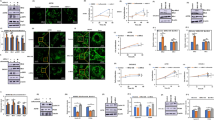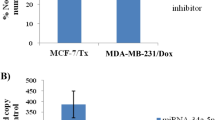Abstract
Upregulation of functional voltage-gated Na+ channels (VGSCs) occurs in metastatic human breast cancer (BCa) in vitro and in vivo. The present study aimed to ascertain the specific involvement of the ‘neonatal’ splice variant of Nav1.5 (nNav1.5), thought to be predominant, in the VGSC-dependent invasive behaviour of MDA-MB-231 cells. Functional activity of nNav1.5 was suppressed by two different methods targeting nNav1.5: (i) small interfering RNA (siRNA), and (ii) a polyclonal antibody (NESO-pAb); effects upon migration and invasion were determined. nNav1.5 mRNA, protein and signalling were measured using real-time PCR, Western blotting, and patch clamp recording, respectively. Treatment with the siRNA rapidly reduced (by ∼90%) the level of nNav1.5 (but not adult Nav1.5) mRNA, but the protein reduction was much smaller (∼30%), even after 13 days. Nevertheless, the siRNA reduced peak VGSC current density by 33%, and significantly increased the cells’ sensitivity to nanomolar tetrodotoxin (TTX). Importantly, the siRNA suppressed in vitro migration by 43%, and eliminated the normally inhibitory effect of TTX. Migrated MDA-MB-231 cells expressed more nNav1.5 protein at the plasma membrane than non-migrated cells. Furthermore, NESO-pAb reduced migration by up to 42%, in a dose-dependent manner. NESO-pAb also reduced Matrigel invasion without affecting proliferation. TTX had no effect on cells already treated with NESO-pAb. It was concluded that nNav1.5 is primarily responsible for the VGSC-dependent enhancement of invasive behaviour in MDA-MB-231 cells. Accordingly, targeting nNav1.5 expression/activity may be useful in clinical management of metastatic BCa.
Similar content being viewed by others
References
Hille B (1992) Ionic channels of excitable membranes, 2nd edn. Sinauer Associates Inc., Sunderland (Massachusetts)
Jurkat-Rott K, Lehmann-Horn F (2001) Human muscle voltage-gated ion channels and hereditary disease. Curr Opin Pharmacol 1(3):280–287
Viswanathan PC, Balser JR (2004) Inherited sodium channelopathies: a continuum of channel dysfunction. Trends Cardiovasc Med 14(1):28–35
Diss JK, Fraser SP, Djamgoz MB (2004) Voltage-gated Na+ channels: multiplicity of expression, plasticity, functional implications and pathophysiological aspects. Eur Biophys J 33(3):180–193
Fraser SP, Koyuturk M, Djamgoz MB (2002) Ion channel activity and cancer cell proliferation: a short review with particular reference to prostate cancer. In: Rouzaire-Dubois B, Benoit E, Dubois JM (eds) Ion channels and physiopathologies of nerve conduction and cell proliferation, 1st edn. Research Signpost
Fraser SP, Diss JK, Chioni AM et al (2005) Voltage-gated sodium channel expression and potentiation of human breast cancer metastasis. Clin Cancer Res 11:5381–5389
Laniado ME, Lalani EN, Fraser SP et al (1997) Expression and functional analysis of voltage-activated Na+ channels in human prostate cancer cell lines and their contribution to invasion in vitro. Am J Pathol 150(4):1213–1221
Fraser SP, Diss JK, Lloyd LJ et al (2004) T-lymphocyte invasiveness: control by voltage-gated Na+ channel activity. FEBS Lett 569(1–3):191–194
Blandino JK, Viglione MP, Bradley WA et al (1995) Voltage-dependent sodium channels in human small-cell lung cancer cells: role in action potentials and inhibition by Lambert-Eaton syndrome IgG. J Membr Biol 143(2):153–163
Onganer PU, Djamgoz MB (2005) Small-cell lung cancer (human): potentiation of endocytic membrane activity by voltage-gated Na+ channel expression in vitro. J Membr Biol 204(2):67–75
Ou SW, Kameyama A, Hao LY et al (2005) Tetrodotoxin-resistant Na+ channels in human neuroblastoma cells are encoded by new variants of Nav1.5/SCN5A. Eur J Neurosci 22(4):793–801
Allen DH, Lepple-Wienhues A, Cahalan MD (1997) Ion channel phenotype of melanoma cell lines. J Membr Biol 155(1):27–34
Abdul M, Hoosein N (2002) Voltage-gated sodium ion channels in prostate cancer: expression and activity. Anticancer Res 22(3):1727–1730
Onganer PU, Seckl MJ, Djamgoz MB (2005) Neuronal characteristics of small-cell lung cancer. Br J Cancer 93:1197–1201
Diss JK, Stewart D, Pani F et al (2005) A potential novel marker for human prostate cancer: voltage-gated sodium channel expression in vivo. Prostate Cancer Prostatic Dis 8(3):266–273
Fidler IJ (2003) Timeline: the pathogenesis of cancer metastasis: the ‘seed and soil’ hypothesis revisited. Nat Rev Cancer 3(6):453–458
Grimes JA, Fraser SP, Stephens GJ et al (1995) Differential expression of voltage-activated Na+ currents in two prostatic tumour cell lines: contribution to invasiveness in vitro. FEBS Lett 369(2–3):290–294
Djamgoz MBA, Mycielska M, Madeja Z et al (2001) Directional movement of rat prostate cancer cells in direct-current electric field: involvement of voltage gated Na+ channel activity. J Cell Sci 114(Pt 14):2697–2705
Mycielska ME, Fraser SP, Szatkowski M et al (2003) Contribution of functional voltage-gated Na+ channel expression to cell behaviors involved in the metastatic cascade in rat prostate cancer: II. Secretory membrane activity. J Cell Physiol 195(3):461–469
Bennett ES, Smith BA, Harper JM (2004) Voltage-gated Na+ channels confer invasive properties on human prostate cancer cells. Pflugers Arch 447(6):908–914
Smith P, Rhodes NP, Shortland AP et al (1998) Sodium channel protein expression enhances the invasiveness of rat and human prostate cancer cells. FEBS Lett 423(1):19–24
Roger S, Besson P, Le Guennec JY (2003) Involvement of a novel fast inward sodium current in the invasion capacity of a breast cancer cell line. Biochim Biophys Acta 1616(2):107–111
Fraser SP, Ding Y, Liu A et al (1999) Tetrodotoxin suppresses morphological enhancement of the metastatic MAT-LyLu rat prostate cancer cell line. Cell Tissue Res 295(3):505–512
Krasowska M, Grzywna ZJ, Mycielska ME et al (2004) Patterning of endocytic vesicles and its control by voltage-gated Na+ channel activity in rat prostate cancer cells: fractal analyses. Eur Biophys J 33(6):535–542
Fraser SP, Salvador V, Manning EA et al (2003) Contribution of functional voltage-gated Na+ channel expression to cell behaviors involved in the metastatic cascade in rat prostate cancer: I. lateral motility. J Cell Physiol 195(3):479–487
Mycielska ME, Palmer CP, Brackenbury WJ et al (2005) Expression of Na+-dependent citrate transport in a strongly metastatic human prostate cancer PC-3M cell line: regulation by voltage-gated Na+ channel activity. J Physiol 563(Pt 2):393–408
Anderson JD, Hansen TP, Lenkowski PW et al (2003) Voltage-gated sodium channel blockers as cytostatic inhibitors of the androgen-independent prostate cancer cell line PC-3. Mol Cancer Ther 2(11):1149–1154
Abdul M, Hoosein N (2001) Inhibition by anticonvulsants of prostate-specific antigen and interleukin-6 secretion by human prostate cancer cells. Anticancer Res 21(3B):2045–2048
Catterall WA (2000) From ionic currents to molecular mechanisms: the structure and function of voltage-gated sodium channels. Neuron 26(1):13–25
Copley RR (2004) Evolutionary convergence of alternative splicing in ion channels. Trends Genet 20(4):171–176
Chioni AM, Fraser SP, Pani F et al (2005) A novel polyclonal antibody specific for the Na(v)1.5 voltage-gated Na+ channel ‘neonatal’ splice form. J Neurosci Methods 147(2):88–98
Brackenbury WJ, Chioni AM, Djamgoz MB (2005) Further evidence for the neonatal splice variant of Nav1.5 potentiating in vitro metastatic behaviour of MDA-MB-231 human breast cancer cells: application of RNAi and a novel antibody. J Physiol 568P:PC17
Altschul SF, Gish W, Miller W et al (1990) Basic local alignment search tool. J Mol Biol 215(3):403–410
Diss JK, Archer SN, Hirano J et al (2001) Expression profiles of voltage-gated Na+ channel alpha-subunit genes in rat and human prostate cancer cell lines. Prostate 48(3):165–178
Livak KJ, Schmittgen TD (2001) Analysis of relative gene expression data using real-time quantitative PCR and the 2 (-Delta Delta C(T)) Method. Methods 25(4):402–408
Okuse K, Malik-Hall M, Baker MD et al (2002) Annexin II light chain regulates sensory neuron-specific sodium channel expression. Nature 417(6889):653–656
Shah BS, Rush AM, Liu S et al (2004) Contactin associates with sodium channel Nav1.3 in native tissues and increases channel density at the cell surface. J Neurosci 24(33):7387–7399
Brackenbury WJ, Djamgoz MB (2006) Activity-dependent regulation of voltage-gated Na+ channel expression in Mat-LyLu rat prostate cancer cell line. J Physiol DOI: 10.1113/jphysiol.2006.106906
Grimes JA, Djamgoz MB (1998) Electrophysiological characterization of voltage-gated Na+ current expressed in the highly metastatic Mat-LyLu cell line of rat prostate cancer. J Cell Physiol 175(1):50–58
Ding Y, Djamgoz MB (2004) Serum concentration modifies amplitude and kinetics of voltage-gated Na+ current in the Mat-LyLu cell line of rat prostate cancer. Int J Biochem Cell Biol 36(7):1249–1260
Haufe V, Camacho JA, Dumaine R et al (2005) Expression pattern of neuronal and skeletal muscle voltage-gated Na+ channels in the developing mouse heart. J Physiol 564 (Pt 3):683–696
Gurney AM, Hunter E (2005) The use of small interfering RNA to elucidate the activity and function of ion channel genes in an intact tissue. J Pharmacol Toxicol Methods 51(3):253–262
Rieckhof GE, Yoshihara M, Guan Z et al (2003) Presynaptic N-type calcium channels regulate synaptic growth. J Biol Chem 278(42):41099–41108
McCrossan ZA, Lewis A, Panaghie G et al (2003) MinK-related peptide 2 modulates Kv2.1 and Kv3.1 potassium channels in mammalian brain. J Neurosci 23(22):8077–8091
Mikami M, Yang J (2005) Short hairpin RNA-mediated selective knockdown of Nav1.8 tetrodotoxin-resistant voltage-gated sodium channel in dorsal root ganglion neurons. Anesthesiology 103(4):828–836
Xu X, Shrager P (2005) Dependence of axon initial segment formation on Na+ channel expression. J Neurosci Res 79(4):428–441
Editorial (2003) Whither RNAi? Nat Cell Biol 5(6):489–490
Couzin J (2004) Molecular biology. RNAi shows cracks in its armor. Science 306(5699):1124–1125
Jackson AL, Bartz SR, Schelter J et al (2003) Expression profiling reveals off-target gene regulation by RNAi. Nat Biotechnol 21(6):635–637
Li T, Chang CY, Jin DY et al (2004) Identification of the gene for vitamin K epoxide reductase. Nature 427(6974):541–544
Zhang W, Lane RD, Mellgren RL (1996) The major calpain isozymes are long-lived proteins. Design of an antisense strategy for calpain depletion in cultured cells. J Biol Chem 271(31):18825–18830
Alao JP, Lam EW, Ali S et al (2004) Histone deacetylase inhibitor trichostatin A represses estrogen receptor alpha-dependent transcription and promotes proteasomal degradation of cyclin D1 in human breast carcinoma cell lines. Clin Cancer Res 10(23):8094–8104
Waechter CJ, Schmidt JW, Catterall WA (1983) Glycosylation is required for maintenance of functional sodium channels in neuroblastoma cells. J Biol Chem 258(8):5117–5123
Sherman SJ, Chrivia J, Catterall WA (1985) Cyclic adenosine 3′:5′-monophosphate and cytosolic calcium exert opposing effects on biosynthesis of tetrodotoxin-sensitive sodium channels in rat muscle cells. J Neurosci 5(6):1570–1576
Rola R, Szulczyk B, Szulczyk P et al (2002) Expression and kinetic properties of Na+ currents in rat cardiac dorsal root ganglion neurons. Brain Res 947(1):67–77
Yoshida S (1994) Tetrodotoxin-resistant sodium channels. Cell Mol Neurobiol 14(3):227–244
Fahmi AI, Patel M, Stevens EB et al (2001) The sodium channel beta-subunit SCN3b modulates the kinetics of SCN5a and is expressed heterogeneously in sheep heart. J Physiol 537(Pt 3):693–700
Xiao YF, Wright SN, Wang GK et al (2000) Coexpression with beta(1)-subunit modifies the kinetics and fatty acid block of hH1(alpha) Na+ channels. Am J Physiol Heart Circ Physiol 279(1):H35–H46
Yu EJ, Ko SH, Lenkowski PW et al (2005) Distinct domains of the sodium channel beta3 subunit modulate channel gating kinetics and sub-cellular location. Biochem J 392(Pt 3):519–526
Monk M, Holding C (2001) Human embryonic genes re-expressed in cancer cells. Oncogene 20(56):8085–8091
Rye PD, Stigbrand T (2004) Interfering with cancer: a brief outline of advances in RNA interference in oncology. Tumour Biol 25(5–6):329–336
Uprichard SL (2005) The therapeutic potential of RNA interference. FEBS Lett 579(26):5996–6007
Karagiannis TC, El-Osta A (2005) RNA interference and potential therapeutic applications of short interfering RNAs. Cancer Gene Ther 12(10):787–795
Willems A, Gauger K, Henrichs C et al (2005) Antibody therapy for breast cancer. Anticancer Res 25(3A):1483–1489
Acknowledgements
We would like to thank Dr. J.P. Alao and Prof R.C. Coombes for advice on design of initial RNAi experiments. This study was supported by the Pro Cancer Research Fund (PCRF) and the Bunzl plc - PCRF Programme in Cancer Research.
Author information
Authors and Affiliations
Corresponding author
Rights and permissions
About this article
Cite this article
Brackenbury, W.J., Chioni, AM., Diss, J.K.J. et al. The neonatal splice variant of Nav1.5 potentiates in vitro invasive behaviour of MDA-MB-231 human breast cancer cells. Breast Cancer Res Treat 101, 149–160 (2007). https://doi.org/10.1007/s10549-006-9281-1
Received:
Accepted:
Published:
Issue Date:
DOI: https://doi.org/10.1007/s10549-006-9281-1




